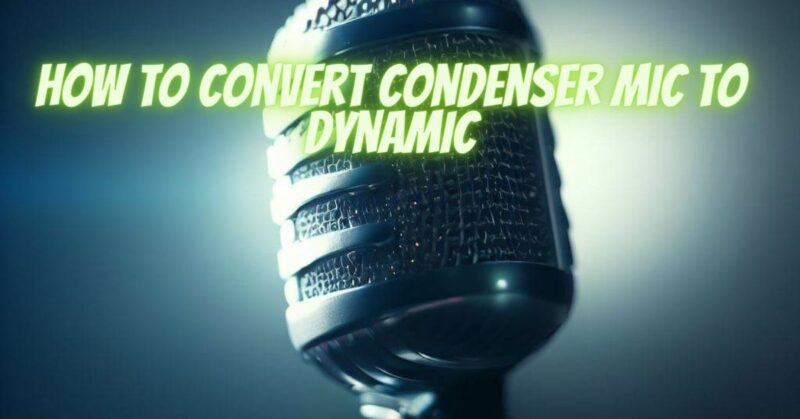Condenser microphones and dynamic microphones are two distinct types of microphones with different operating principles. While each type has its advantages and applications, you may find yourself in a situation where you want to convert a condenser microphone to a dynamic microphone. Converting a condenser microphone to dynamic requires a few modifications and considerations to ensure proper functionality. In this article, we will provide a step-by-step guide on how to convert a condenser microphone to a dynamic microphone.
Important Note: Converting a condenser microphone to dynamic involves irreversible modifications to the microphone’s internal components. It requires technical expertise and should only be attempted by individuals with the necessary knowledge and experience. Additionally, modifying a condenser microphone may void its warranty. Proceed with caution and at your own risk.
Step 1: Gather the Required Tools and Materials: To perform the conversion, you will need the following tools and materials:
- Condenser microphone
- Dynamic microphone cartridge (compatible with the condenser microphone’s body)
- Soldering iron and solder
- Wire cutters/strippers
- Heat shrink tubing or electrical tape
- Screwdrivers (if necessary for disassembling the microphone)
Step 2: Disassemble the Condenser Microphone: Carefully disassemble the condenser microphone, following the manufacturer’s instructions if available. Take note of the microphone’s internal components and wiring connections.
Step 3: Remove the Condenser Microphone Capsule: Locate the condenser microphone capsule, which is responsible for converting sound waves into electrical signals. Disconnect the wires connected to the capsule and remove it from the microphone body.
Step 4: Prepare the Dynamic Microphone Cartridge: Take the dynamic microphone cartridge and prepare it for installation. Ensure that the cartridge is compatible with the condenser microphone’s body in terms of size and electrical requirements.
Step 5: Wire the Dynamic Cartridge: Connect the wires from the dynamic microphone cartridge to the corresponding points on the microphone body. This may involve soldering the wires to the appropriate terminals or connectors. Refer to the microphone’s original wiring or consult technical documentation if available.
Step 6: Secure the Connections: Once the wiring is complete, insulate the connections using heat shrink tubing or electrical tape. This helps prevent any short circuits and ensures a secure and reliable connection.
Step 7: Reassemble the Microphone: Carefully reassemble the condenser microphone, ensuring that all components are properly aligned and secured. Follow the manufacturer’s instructions for proper reassembly, if available.
Step 8: Test and Fine-tune: Once the microphone is reassembled, connect it to an audio interface or mixer and test its functionality. Make any necessary adjustments to the wiring or connections if the microphone does not function as expected. Fine-tuning may be required to achieve optimal performance.
Conclusion:
Converting a condenser microphone to a dynamic microphone involves replacing the condenser capsule with a dynamic cartridge and rewiring the microphone accordingly. This process requires technical expertise, soldering skills, and an understanding of microphone internals. It’s important to note that modifying a condenser microphone may have unpredictable results, and the performance of the converted microphone may not match that of a true dynamic microphone. If you’re not confident in performing the conversion yourself, it’s recommended to consult with a professional or consider purchasing a dedicated dynamic microphone for your specific needs.


